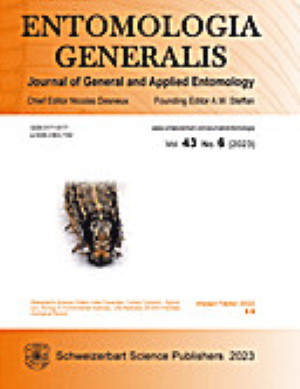Callows have their own odour but not for long: Fast acquisition of the chemical signature in the yellow-legged hornet, Vespa velutina nigrithorax
IF 4.6
1区 农林科学
Q1 ENTOMOLOGY
引用次数: 0
Abstract
In eusocial insects, the discrimination between conspecifics and intruders is essential for the functioning of most insect societies. This capacity mediated by pheromones, and in particular by Cuticular Hydrocarbon Compounds (CHCs) is the main mechanism of social nestmate recognition which can include heritable cues, as well as acquired cues from nestmates and/or their environment. In this study, we analysed the acquisition of the chemical signature of callows over time, compared to nestmate workers and their nest materials in the invasive hornet Vespa velutina nigrithorax. We show that callows present their own chemical signature, different from both the oldest individuals and nest materials. Interestingly, this chemical signature evolves rapidly, the first two days after emergence, and is not influenced by the presence of a chemical template (workers and/or nests) in laboratory conditions. Moreover, quantities of branched alkanes increased with age. All these results suggest that the chemical signature in V. velutina nigrithorax is probably more influenced by some parameters like physiological processes or genetic factors.Callows有自己的气味,但不会持续太久:快速获取黄腿大黄蜂(Vespa velutina nigrithorax)的化学特征
在真社会性昆虫中,同种昆虫和入侵者之间的区分对大多数昆虫社会的功能至关重要。这种由信息素,特别是由表皮烃化合物(CHCs)介导的能力是社会配偶识别的主要机制,它可以包括遗传线索,也可以包括从配偶和/或其环境中获得的线索。在这项研究中,我们分析了随着时间的推移,羽衣甘蓝的化学特征的获取,并将其与入侵大黄蜂黄蜂的巢工蜂及其巢材料进行了比较。我们表明,胼胝体呈现出自己的化学特征,不同于最古老的个体和巢穴材料。有趣的是,这种化学特征在出现后的头两天迅速演变,并且不受实验室条件下化学模板(工蚁和/或巢穴)存在的影响。此外,支链烷烃的数量随年龄增长而增加。这些结果表明,黑胸白叶藻的化学特征可能更多地受到生理过程或遗传因素等参数的影响。
本文章由计算机程序翻译,如有差异,请以英文原文为准。
求助全文
约1分钟内获得全文
求助全文
来源期刊

Entomologia Generalis
生物-昆虫学
CiteScore
7.10
自引率
18.80%
发文量
72
审稿时长
>12 weeks
期刊介绍:
Its scope covers all aspects of basic and applied research dealing with insects and more broadly with arthropods inhabiting wild, agricultural and/or urban habitats. The journal also considers research integrating various disciplines and issues within the broad field of entomology and ecology.
Entomologia Generalis publishes high quality research articles on advances in knowledge on the ecology and biology of arthropods, as well as on their importance for key ecosystems services, e.g. as biological control and pollination. The journal devotes special attention to contributions providing significant advances (i) on the fundamental knowledge and on sustainable control strategies of arthropod pests (including of stored products) and vectors of diseases, (ii) on the biology and ecology of beneficial arthropods, (iii) on the spread and impact of invasive pests, and (iv) on potential side effects of pest management methods.
Entomologia Generalis welcomes review articles on significant developments in the field of entomology. These are usually invited by the editorial board, but proposals may be sent to the Editor-in-Chief for preliminary assessment by the editorial board before formal submission to the journal. The journal also considers comments on papers published in Entomologia Generalis, as well as short notes on topics that are of broader interest.
 求助内容:
求助内容: 应助结果提醒方式:
应助结果提醒方式:


